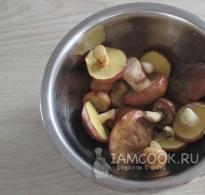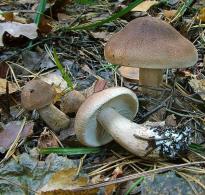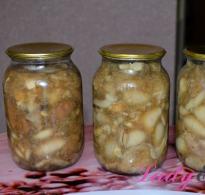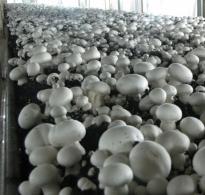Growing champignons at home - step by step technology
The cultivation of champignons as a business first developed in Europe, and somewhat later appeared in Russia.
Cultivation of champignon mushrooms can be done not only for commercial purposes, but also for yourself.
Knowing the principles of their cultivation, you can earn good money, quickly develop your own business and harvest a good harvest.
For growing mushrooms, not only production conditions, but also home conditions are suitable. You can plant mushroom mycelium (mycelium) in the country, in the vegetable garden, garden, garage or barn.
This article will tell you how to do this correctly.
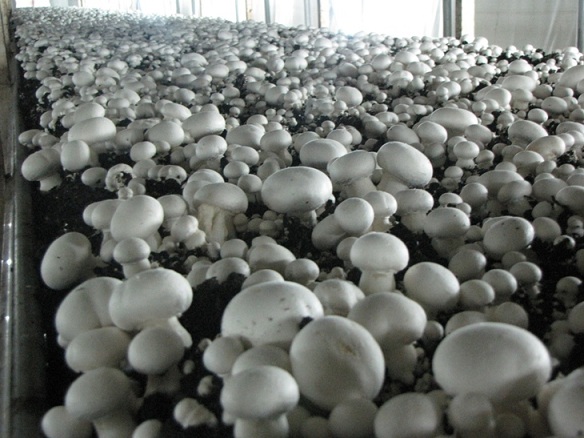 Growing mushrooms at home can be done in several ways. Each of them has its own characteristics and specifics:
Growing mushrooms at home can be done in several ways. Each of them has its own characteristics and specifics:
- In the garden or in the garden. Cultivation of mushrooms in the open field, of course, will not give a high yield, but it is quite suitable for providing a family with mushrooms. This option involves sowing mushroom mycelium in compost. To do this, organic waste from the compost pit is laid in an even layer on the site selected for sowing mycelium. The mycelium itself is planted in early spring. Subsequent care for it consists in regular watering of the compost. The width of the beds with compost, prepared for planting the mushroom mycelium, should be up to 1.5 m. In order for the mushrooms to grow well, it is recommended to moisten the soil under them as it dries;
- In the basement... Breeding champignons is a good option. This room has a suitable microclimate, because the temperature and humidity level in it will change slightly (which is especially important for obtaining a high yield of mushrooms). However, this method also has its drawbacks. In particular, the basement must be well ventilated. The walls and ceiling in such a room must be concrete;
- In the garage. The garage is another suitable place for growing a good harvest of champignons. It is equipped with durable wall shelves. Compost is laid out on them in an even layer, in which they are then sown mushroom spores... Some artisans plant mushroom mycelium on the garage floor. (About how to build a garage from foam blocks, read
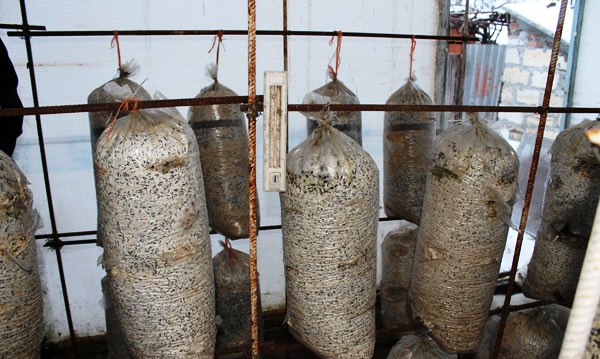
- In the greenhouse. The cultivation of mushrooms is carried out according to the same principle as in the open field. The only difference is the need to create arcs under the greenhouse film and stretch the film itself;
- In bags. The method of growing mushrooms in bags received good reviews. One of the most convenient ways to pack mushroom mycelium is to place it in a plastic container. This does not require large material costs and specialized equipment. First, the substrate is prepared for planting the mushroom mycelium and kept for several days until it is completely burned out (decomposition of the mixture components). The prepared soil mixture is placed in bags and well rammed. Then spores of fungi are sown in it;
- Houses. You can get a large harvest of champignons at home if you choose the right place for planting mycelium. Breeding champignons inside the house is considered one of the suitable options. Champignons, like any other mushrooms, love shade and a lot of moisture. Instead of plastic bags, containers with a large number of holes over the entire surface can be used for laying the substrate and sowing spores. In them, the mycelium will develop well due to good ventilation and maintaining high humidity.
Substrate (soil mixture) for growing mushrooms at home
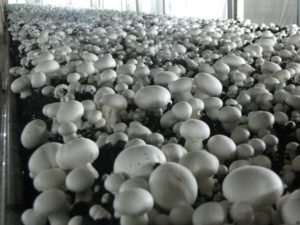 The substrate for growing mushrooms is an artificially created soil mixture saturated with nutrients.
The substrate for growing mushrooms is an artificially created soil mixture saturated with nutrients.
The preparation of the substrate (soil mixture) for growing mushrooms is the most crucial stage in all the work.
Most suitable for such mushrooms is a composition in which compost (prepared from straw with the addition of wheat seed) and horse manure are present.
If there is no horse manure, it is replaced with cow or bird droppings (and the latter component is used with caution, since champignons do not tolerate it well).
The technology for creating a nutrient mixture for growing mushrooms is as follows:
- For 1 sq.m. of the area of the selected area, about 30 kg of straw is taken (less is impossible, since the process of its decomposition will proceed poorly) and 15 kg of manure (horse or cow). Straw for composting is chosen fresh, without signs of mold. For 2-4 days, it is recommended to moisten the straw with water (water it with a hose, or place it in a large container with water)
- Prepared straw and manure are placed alternately so as to form 3-4 layers of each component. Each layer of straw is additionally moistened with water and sprinkled with a thin layer (1 cm) of fertilizer (ammonium nitrate). The finished substrate should be about 1.2 m in length, and at least 1.5 m in height with width
- 7 days after the formation of the substrate, it is necessary to add 7 kg of gypsum, which helps to improve the structure of the mixture and mix all the layers of the substrate with a pitchfork
- 4 days after the first interruption (mixing), do the second. If the substrate is not wet enough, it is well watered with water, and 5 kg of crushed chalk and 2 kg of superphosphate fertilizer are added to it
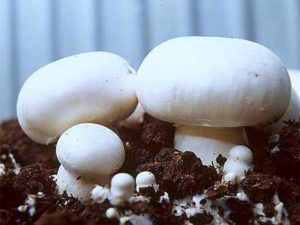
- The third time, stirring is carried out 4 days after the second. The same time interval is maintained before the 4th mixing of the components
- Typically, the mushroom substrate is considered ready 3-4 weeks after formation. Its maturity is evidenced by the absence of ammonia odor, strong softening of the straw and the dark brown color of the mixture.
- If the mixture is oversaturated with moisture, it is recommended to scatter and dry it for 1-2 days, adding 1 kg of chalk to it. In general, it takes 20-22 days to prepare a high-quality substrate.
- The finished compost is stacked on racks or in special boxes at the rate of 100 kg per 1 sq. M. area.
If it is not possible to prepare a substrate for growing mushrooms at home, you can buy it ready-made in a special store.
In addition, at home you can make a soil mixture for growing mushrooms from other ingredients.
Ingredients such as straw, wheat, rye, nitrogen fertilizers, crushed corn cobs, rabbit (or bird) manure, household waste mix well with each other and are composted.
There are no exact proportions for the preparation of the substrate, everything will depend on the area of the room in which they plan to grow the mushrooms.
The only thing that must be done is to stir the mixture during the ripening (burnout) period every 3-4 days. The finished composition should not have a strong ammonia odor.
Planting mycelium (mycelium)
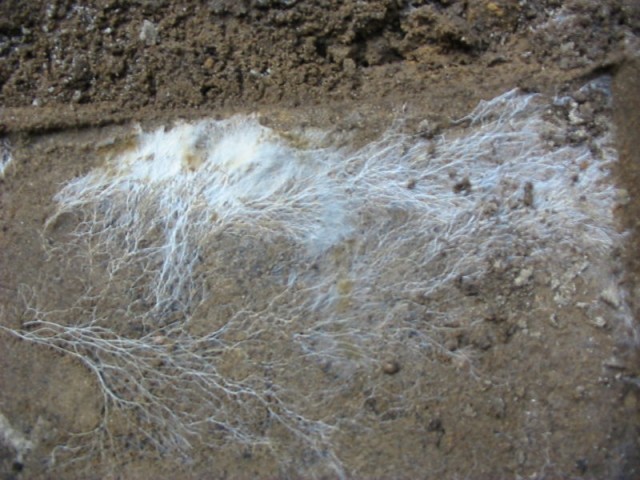 Sowing the mycelium (mycelium) of mushrooms is carried out in different ways, depending on the place chosen for planting.
Sowing the mycelium (mycelium) of mushrooms is carried out in different ways, depending on the place chosen for planting.
For example, in bags for laying mycelium, special holes are made over the entire surface area. About 15 kg of compost is poured into the bags, and then the mycelium is planted.
Advice! When sowing mycelium, keep an eye on the temperature in the room (it should not exceed 25 ºC) and the humidity level (should be about 70%).
In order for the harvest of mushrooms to be large and good, only high-quality mycelium is selected for sowing. In mushroom growing, two types of mycelium are known:
- Compost, characterized by low productivity and low susceptibility to negative external influences. The consumption of the compost mycelium is 500 g per 1 sq.
- Grain - it is packed in plastic bags, consumption is 400 g per sq.m.
The mycelium is buried into the substrate by 5-7 cm, after which it is covered with a layer of the substrate (about 10 cm thick) and the spores of the fungus are placed again.
Planting is recommended to be carried out in a checkerboard pattern, leaving about 20 cm between adjacent sections of the substrate. A week after planting, the mycelium will grow and its cobweb-like threads will already become noticeable in the substrate.
During this period, it is very important to maintain the optimum humidity level in the room where the mushrooms are grown. On the surface of the substrate, mycelium appears 2-3 weeks after planting.
About 5 days before this time, you need to prepare the casing layer. It can be crafted from chalk (1 part) and peat (9 parts).
If mushrooms are grown in a room that is too damp, it is advisable to prepare the casing layer from a mixture of sand (1 part) and loam (2 parts).
It is introduced on top of a layer of substrate with sprouted mycelium, keeping to a thickness of 3-5 cm (about 4 buckets per 1 sq.m. of substrate area).
4 days after applying the casing layer, it is necessary to slightly adjust the temperature in the room where the mushrooms grow. A good harvest of mushrooms will be obtained if they grow at a temperature of 14-17 ºC.
How to care for mushrooms
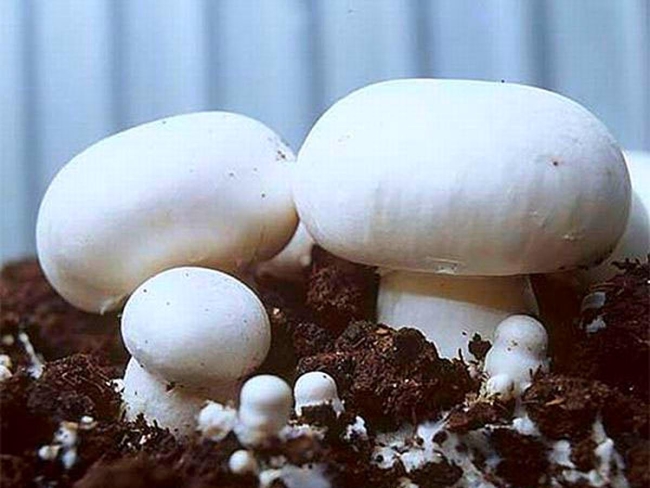 Caring for the planted champignons requires regular watering of the substrate and maintaining optimal humidity and temperature in the room.
Caring for the planted champignons requires regular watering of the substrate and maintaining optimal humidity and temperature in the room.
In general, this procedure must be performed carefully and carefully, since water must remain in the upper, covering layer of the substrate, and in no case penetrate into the compost (otherwise the mycelium will rot and quickly disappear).
The humidity in the room where the mushrooms grow should be kept at the level of 75-80%. To achieve such indicators, special shelves are equipped there and several basins of water are installed on them.
For mushrooms, a high concentration of carbon dioxide will be destructive, so the room must be ventilated at least once a day.
How to collect mushrooms
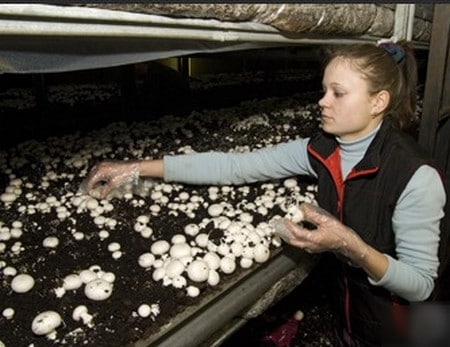 Active fruiting of mushrooms can last from 2 to 4 months, and the whole process is uneven.
Active fruiting of mushrooms can last from 2 to 4 months, and the whole process is uneven.
The active growth of mushrooms continues for 3-4 days (the first harvest will appear 30-35 days after sowing the mycelium), then a week of calm, and after it the yield peak again.
Most of the total harvest can be harvested in the first three waves of active growth of mushrooms (there can be up to seven such waves in total).
You can determine the maturity of the mushrooms by the film connecting the stem of the fruit and its cap (it should darken, but not yet be torn).
Ripe champignons are harvested very carefully so as not to damage the rudiments of fruit bodies located nearby. To do this, you need to grab the leg of the mushroom with your fingers and, carefully turning the fruit, remove it from the substrate.
This should also be done very carefully so as not to damage the mycelium, on which the further mushroom harvest depends.
When the entire crop of mushrooms is harvested, the spent compost is removed, and the room must be treated with a solution of bleach (4%) to kill microbes.
You can learn more about the features of growing champignons at home from this video:

